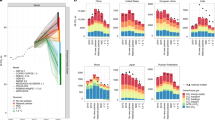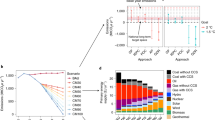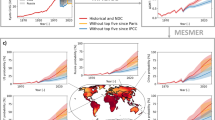Abstract
Integrated assessment models can help in quantifying the implications of international climate agreements and regional climate action. This paper reviews scenario results from model intercomparison projects to explore different possible outcomes of post-2020 climate negotiations, recently announced pledges and their relation to the 2 °C target. We provide key information for all the major economies, such as the year of emission peaking, regional carbon budgets and emissions allowances. We highlight the distributional consequences of climate policies, and discuss the role of carbon markets for financing clean energy investments, and achieving efficiency and equity.
This is a preview of subscription content, access via your institution
Access options
Subscribe to this journal
Receive 12 print issues and online access
$209.00 per year
only $17.42 per issue
Buy this article
- Purchase on Springer Link
- Instant access to full article PDF
Prices may be subject to local taxes which are calculated during checkout






Similar content being viewed by others
References
Blanford, G., Kriegler, E. & Tavoni, M. Harmonization vs. fragmentation: overview of climate policy scenarios in EMF27. Clim. Change 123, 383–396 (2014).
UNFCCC. Establishment of an Ad Hoc Working Group on the Durban Platform for Enhanced Action. Draft decision -/CP.17 (UNFCCC, 2011).
Pachauri, S. et al. Pathways to achieve universal household access to modern energy by 2030. Environ. Res. Lett. 8, 024015 (2013).
McCollum, D. L., Krey, V. & Riahi, K. An integrated approach to energy sustainability. Nature Clim. Change 1, 428–429 (2011).
Rogelj, J., McCollum, D. L., Reisinger, A., Meinshausen, M. & Riahi, K. Probabilistic cost estimates for climate change mitigation. Nature 493, 79–83 (2013). This paper quantifies the uncertainties surrounding climate mitigation costs using an IAM.
Rogelj, J., McCollum, D. L., O'Neill, B. C. & Riahi, K. 2020 emissions levels required to limit warming to below 2 degrees. Nature Clim. Change 3, 405–412 (2013).
Rogelj, J., McCollum, D. L. & Riahi, K. The UN's 'Sustainable Energy for All' initiative is compatible with a warming limit of 2 °C. Nature Clim. Change 3, 545–551 (2013).
Luderer, G. et al. Economic mitigation challenges: how further delay closes the door for achieving climate targets. Environ. Res. Lett. 8, 034033 (2013).
Den Elzen, M. G. J. & van Vuuren, D. Peaking profiles for achieving long-term temperature targets with more likelihood at lower costs. Proc. Natl Acad. Sci. 104, 17931–17936 (2007).
Rogelj, J. et al. Emission pathways consistent with a 2 °C global temperature limit. Nature Clim. Change 1, 413–418 (2011).
Riahi, K. et al. Locked into Copenhagen pledges − Implications of short-term emission targets for the cost and feasibility of long-term climate goals. Technol. Forecast. Social Change http://dx.doi.org/10.1016/j.techfore.2013.09.016 (2014).
Kriegler, E. et al. The role of technology for achieving climate policy objectives: Overview of the EMF 27 study on global technology and climate policy strategies. Clim. Change 123, 353–367 (2014). This is one of the latest and largest MIP projects, with a focus on the role of technology for mitigation.
Kriegler, E. et al. What does the 2 °C target imply for a global climate agreement in 2020? The LIMITS study on Durban platform scenarios. Clim. Change Econ. 4, 1340008 (2013).
Tavoni, M. et al. The distribution of the major economies' effort in the Durban platform scenarios. Clim. Change Econ. 4, 1340009 (2013).
Kriegler, E., Tavoni, M., Riahi, K. & van Vuuren, D. P. Introducing the LIMITS special issue. Clim. Change Econ. 4, 1302002 (2013). This paper introduces the special issue of the LIMITS MIP.
Clarke, L. et al. International climate policy architectures: Overview of the EMF 22 International Scenarios. Energy Econ. 31, S64–S81 (2009). This is one of the first MIP papers that looked into climate agreements, and its public data set has been used widely.
Kriegler, E. et al. Making or breaking climate targets: The AMPERE study on staged accession scenarios for climate policy. Technol. Forecast. Social Change. (in the press); available at http://dx.doi.org/10.1016/j.techfore.2013.09.021 (2014).
Jakob, M., Luderer, G., Steckel, J., Tavoni, M. & Monjon, S. Time to act now? Assessing the costs of delaying climate measures and benefits of early action. Clim. Change 114, 79–99 (2012).
Luderer, G., Bertram, C., Calvin, K., Cian, E. & Kriegler, E. Implications of weak near-term climate policies on long-term mitigation pathways. Clim. Change http://dx.doi.org/10.1007/s10584-013-0899-9 (2013).
Luderer, G. et al. On the regional distribution of mitigation costs in a global cap-and-trade regime. Clim. Change 114, 59–78 (2012).
Aldy, J. E. & Stavins, R. N. Climate negotiators create an opportunity for scholars. Science 337, 1043–1044 (2012).
Edenhofer, O. et al. Identifying Options for a New International Climate Regime Arising from the Durban Platform for Enhanced Action (Harvard Project on Climate Agreements/Mercator Research Institute on Global Commons and Climate Change, 2013).
Ranson, M. & Stavins, R. N. Linkage as a foundation for post-Durban climate policy architecture. Ethics Policy Environ. 15, 272–275 (2012).
Aldy, J. E. & Stavins, R. N. Designing the Post-Kyoto Climate Regime: Lessons from the Harvard Project on International Climate Agreements. http://belfercenter.hks.harvard.edu/publication/18686/designing_the_postkyoto_climate_regime.html (2008). This paper discusses a variety of issues regarding post Kyoto climate policies.
Den Elzen, M. G. J., Lucas, P. L. & van Vuuren, D. Regional abatement action and costs under allocation schemes for emission allowances for achieving low CO2-equivalent concentrations. Clim. Change 90, 243–268 (2008).
Den Elzen, M. & Höhne, N. Sharing the reduction effort to limit global warming to 2 °C. Clim. Policy 10, 247–260 (2010).
Ekholm, T. et al. Effort sharing in ambitious, global climate change mitigation scenarios. Energy Policy 38, 1797–1810 (2010).
UNFCCC. The Cancun agreements: Outcome of the work of the Ad Hoc Working Group on Long-term Cooperative Action under the Convention. http://unfccc.int/resource/docs/2010/cop16/eng/07a01.pdf#page=2 (2010).
Blanford, G. J., Rose, S. K. & Tavoni, M. Baseline projections of energy and emissions in Asia. Energy Econ. 34, S284–S292 (2012).
Allen, M. et al. Warming caused by cumulative carbon emissions towards the trillionth tonne. Nature 458, 1163–1166 (2009).
Meinshausen, M. et al. Greenhouse-gas emission targets for limiting global warming to 2 degrees C. Nature 458, 1158–1162 (2009).
Zickfeld, K., Eby, M., Matthews, H. D. & Weaver, A. J. Setting cumulative emissions targets to reduce the risk of dangerous climate change. Proc. Natl Acad. Sci. USA 106, 16129–16134 (2009).
Chen, W., Yin, X. & Zhang, H. Towards low carbon development in China: a comparison of national and global models. Clim. Change http://dx.doi.org/10.1007/s10584-013-0937–7 (2013).
Hoogwijk, M. et al. Assessment of bottom-up sectoral and regional mitigation potentials. Energy Policy 38, 3044–3057 (2010).
van der Zwaan, B. C. C. et al. A cross-model comparison of global long-term technology diffusion under a 2 °C climate change control target. Clim. Change Econ., 4, 1340013: 1–24 (2013).
Krey, V., Luderer, G., Clarke, L. & Kriegler, E. Getting from here to there — energy technology transformation pathways in the EMF27 scenarios. Clim. Change 123, 369–382 (2014).
Fischedick, M. et al. in IPCC Special Report on Renewable Energy Sources and Climate Change Mitigation (eds Edenhofer, O. et al.) 74 (Cambridge Univ. Press, 2011).
Clarke, L., Krey, V., Weyant, J. & Chaturvedi, V. Regional energy system variation in global models: Results from the Asian Modeling Exercise scenarios. Energy Econ. 34, S293–S305 (2012).
Popp, A. et al. Land-use transition for bioenergy and climate stabilization: model comparison of drivers, impacts and interactions with other land use based mitigation options. Clim. Change http://dx.doi.org/10.1007/s10584-013-0926-x (2013).
Rose, S. K. et al. Bioenergy in energy transformation and climate management. Clim. Change 123, 477–493 (2014).
Lucas, P. L., van Vuuren, D., Olivier, J. G. J. & den Elzen, M. G. J. Long-term reduction potential of non-CO2 greenhouse gases. Environ. Sci. Policy 10, 85–103 (2007).
Calvin, K., Clarke, L., Krey, V. & Blanford, G. The role of Asia in mitigating climate change: Results from the Asia Modeling Exercise. Energy Econ. (2012).
Riahi, K. et al. in The Global Energy Assessment: Toward a Sustainable Future (IIASA/Cambridge Univ. Press, 2012).
Kunreuther, H. et al. Risk management and climate change. Nature Clim. Change 3, 447–450 (2013).
Millner, A., Dietz, S. & Heal, G. Ambiguity and climate policy. Natl Bur. Econ. Res. Working Pap. 16050 (2010).
Edenhofer, O. et al. The economics of low stabilization: Model comparison of mitigation strategies and costs. Energy J. 31, 11–48 (2010).
Staub-Kaminski, I., Zimmer, A., Jakob, M. & Marschinski, R. Climate policy in practice: A Typology of obstacles and implications for integrated assessment modeling. Clim. Change Econ. 5, http://dx.doi.org/10.1142/S2010007814400041 (2014).
Höhne, N., Den Elzen, M. G. J. & Escalante, D. Regional greenhouse gas mitigation targets based on effort sharing: A comparison of studies. Clim. Policy 14, 122–147 (2014).
Den Elzen, M. & Höhne, N. Reductions of greenhouse gas emissions in Annex I and non-Annex I countries for meeting concentration stabilisation targets. Clim. Change 91, 249–274 (2008).
Johansson, D. J. et al. Multi-model Analyses of the Economic and Energy Implications for China and India in a Post-Kyoto Climate Regime. Kiel Working Paper 1808 (Kiel Institute, 2012).
Jiahua, P. Carbon budget for basic needs satisfaction: Implications for international equity and sustainability. World Econ. Polit. 1, 003 (2008).
Ding, Z. L., Duan, X. N., Ge, Q. S. & Zhang, Z. Q. Control of atmospheric CO2 concentrations by 2050: A calculation on the emission rights of different countries. Sci. China Ser. D Earth Sci. 52, 1447–1469 (2009).
Jewell, J., Cherp, A. & Riahi, K. Energy security under de-carbonization scenarios: An assessment framework and evaluation under different technology and policy choices. Energy Policy 65, 743–760 (2014).
Hof, A. F., Den Elzen, M. G. J. & Van Vuuren, D. P. Environmental effectiveness and economic consequences of fragmented versus universal regimes: what can we learn from model studies? Int. Environ. Agreem. Polit. Law Econ. 9, 39–62 (2009).
Clarke, L. et al. International climate policy architectures: Overview of the EMF 22 International Scenarios. Energy Econ. 31 (Suppl. 2), S64–S81 (2009).
Edenhofer, O. et al. The economics of low stabilization: Model comparison of mitigation strategies and costs. Energy J. 31, 11–48 (2010).
Lüken, M. et al. The role of technological availability for the distributive impacts of climate change mitigation policy. Energy Policy 39, 6030–6039 (2011).
Aboumahboub, T. et al. On the regional distribution of climate mitigation costs: the impact of delayed cooperative action. Clim. Change Econ. 05, 1440002 (2014).
OECD. OECD Environmental Outlook to 2030 (OECD, 2008).
Massetti, E. & Tavoni, M. The cost of climate change mitigation policy in eastern Europe and former Soviet Union. Clim. Change Econ. 2, 341–370 (2011).
Van Vuuren, D. et al. Comparison of top-down and bottom-up estimates of sectoral and regional greenhouse gas emission reduction potentials. Energy Policy 37, 5125–5139 (2009).
Stern, D. I., Pezzey, J. C. V. & Lambie, N. R. Where in the world is it cheapest to cut carbon emissions? Aust. J. Agric. Resource Econ. 56, 315–331 (2012).
Paltsev, S., Reilly, J., Jacoby, H. D. & Tay, K. H. in Human-Induced Climate Change (Schlesinger, M. E. et al.) 282–293 (Cambridge Univ. Press, 2007).
Kober, T., van der Zwaan, B. C. C. & Rosler, H. Emission certificate trade and costs under regional burden-sharing regimes for a 2 °C climate change control target. Clim. Change Econ. 5, 1440001 (2014).
Tavoni, M., Chakravarty, S. & Socolow, R. Safe vs. fair: a formidable trade-off in tackling climate change. Sustainability 4, 210–226 (2012).
IEA. Energy Technology Perspectives 2012 (OECD/IEA, 2012).
Carraro, C., Favero, A. & Massetti, E. Investments and public finance in a green, low carbon, economy. Energy Econ. 34 (Suppl. 1), S15–S28 (2012).
McCollum, D. et al. Energy investments under climate policy: A comparison of global models. Clim. Change Econ. 4, 1340010 (2013).
Bosetti, V., Carraro, C., Massetti, E., Sgobbi, A. & Tavoni, M. Optimal energy investment and R&D strategies to stabilize atmospheric greenhouse gas concentrations. Resource Energy Econ. 31, 123–137 (2009).
IEA. Global Gaps in Clean Energy RD&D: Updates and Recommendations for International Collaboration (IEA, 2010). Available at http://www.iea.org/publications/freepublications/publication/global_gaps.pdf.
Marangoni, G. & M. Tavoni. The clean energy R&D strategy for 2 °C. Clim. Change Econ. 5, 1440003 (2014).
Nemet, G. F. & Kammen, D. M. US energy research and development: Declining investment, increasing need, and the feasibility of expansion. Energy Policy 35, 746–755 (2007).
Popp, D. ENTICE-BR: The effects of backstop technology R&D on climate policy models. Energy Econ. 28, 188–222 (2006).
IMF. Energy Subsidy reform: Lessons and implications. Available at https://www.imf.org/external/np/pp/eng/2013/012813.pdf (2013).
IEA. World Energy Outlook 2012 (OECD/IEA, 2012).
Bowen, A., Campiglio, E. & Tavoni, M. A macroeconomic perspective on climate change mitigation: Meeting the financing challenge. Clim. Change Econ. 5, 1440005 (2014).
Wara, M. Is the global carbon market working? Nature 445, 595–596 (2007).
Jewell, J. et al. Energy security of China, India, the E.U. and the U.S. under long-term scenarios: Results from six IAMs. Clim. Change Econ. 4, 1340011 (2013).
Cherp, A., Jewell, J., Vinichenko, V., Bauer, N. & De Cian, E. Global energy security under different climate policies, GDP growth rates and fossil resource availabilities. Clim. Change (in the press). Available at http://dx.doi.org/10.1007/s10584-013-0950-x (2013).
Rose, S. K. et al. Non-Kyoto radiative forcing in long-run greenhouse gas emissions and climate change scenarios. Clim. Change 123, 511–525 (2014).
Bollen, J., van der Zwaan, B. C. C., Brink, C. & Eerens, H. Local air pollution and global climate change: A combined cost-benefit analysis. Resource Energy Econ. 31, 161–181 (2009).
Rafaj, P., Schöpp, W., Russ, P., Heyes, C. & Amann, M. Co-benefits of post-2012 global climate mitigation policies. Mitig. Adapt. Strateg. Glob. Change 18, 801–824 (2013).
Rao, S. et al. Better air for better health: Forging synergies in policies for energy access, climate change and air pollution. Glob. Environ. Change 23, 1122–1130 (2013).
Nemet, G. F., Holloway, T. & Meier, P. Implications of incorporating air-quality co-benefits into climate change policymaking. Environ. Res. Lett. 5, 014007 (2010).
Barrett, S. Self-enforcing international environmental agreements. Oxf. Econ. Pap. 46, 878–894 (1994). This provides a classic introduction to the issue of stability of climate agreements.
Carraro, C. & Siniscalco, D. Strategies for the international protection of the environment. J. Public Econ. 52, 309–328 (1993).
Tulkens, H. & Chander, P. The core of an economy with multilateral environmental externalities. Int. J. Game Theory 26, 379–401 (1997).
Finus, M., Van Ierland, E. & Dellink, R. Stability of Climate Coalitions in a Cartel Formation Game. Available at http://papers.ssrn.com/sol3/papers.cfm?abstract_id=447461 (Fondazione Eni Enrico Mattei, 2003).
Fuentes-Albero, C. & Rubio, S. J. Can international environmental cooperation be bought? Eur. J. Operat. Res. 202, 255–264 (2010).
Barrett, S. & Dannenberg, A. Sensitivity of collective action to uncertainty about climate tipping points. Nature Clim. Change 4, 36–39 (2013).
Bosetti, V., Carraro, C., De Cian, E., Massetti, E. & Tavoni, M. Incentives and stability of international climate coalitions: An integrated assessment. Energy Policy 55, 44–56 (2013).
Nagashima, M., Dellink, R., van Ierland, E. & Weikard, H-P. Stability of international climate coalitions: A comparison of transfer schemes. Ecol. Econ. 68, 1476–1487 (2009).
Bréchet, T., Gerard, F. & Tulkens, H. Efficiency vs. stability in climate coalitions: a conceptual and computational appraisal. Energy J. 32, 49 (2011).
Carbone, J. C., Helm, C. & Rutherford, T. F. The case for international emission trade in the absence of cooperative climate policy. J. Environ. Econ. Managem. 58, 266–280 (2009).
Tol, R. S. Climate coalitions in an integrated assessment model. Comput. Econ. 18, 159–172 (2001).
Lessmann, K. et al. The stability and effectiveness of climate coalitions: A comparative analysis of multiple integrated assessment models. FEEM Working Pap. 2014.005 Available at http://services.bepress.com/feem/paper868/ (2014).
Acknowledgements
The research leading to these results has received funding from the European Union Seventh Framework Programme FP7/2007-2013 under grant agreement no. 282846 (LIMITS).
Author information
Authors and Affiliations
Contributions
M.T., E.K., K.R. and D.V.V. conceived and designed the experiments. All authors performed the experiments. M.T. analysed the data and contributed materials and analysis tools. All authors wrote the paper.
Corresponding author
Ethics declarations
Competing interests
The authors declare no competing financial interests.
Supplementary information
Supplementary Information
Supplementary Figures and tables (PDF 1064 kb)
Rights and permissions
About this article
Cite this article
Tavoni, M., Kriegler, E., Riahi, K. et al. Post-2020 climate agreements in the major economies assessed in the light of global models. Nature Clim Change 5, 119–126 (2015). https://doi.org/10.1038/nclimate2475
Received:
Accepted:
Published:
Issue Date:
DOI: https://doi.org/10.1038/nclimate2475
This article is cited by
-
Reshoring silicon photovoltaics manufacturing contributes to decarbonization and climate change mitigation
Nature Communications (2023)
-
Identifying energy model fingerprints in mitigation scenarios
Nature Energy (2023)
-
Randomized national land management strategies for net-zero emissions
Nature Sustainability (2022)
-
Unintended consequences of climate change mitigation for African river basins
Nature Climate Change (2022)
-
Carbon price forecasting based on news text mining considering investor attention
Environmental Science and Pollution Research (2022)



